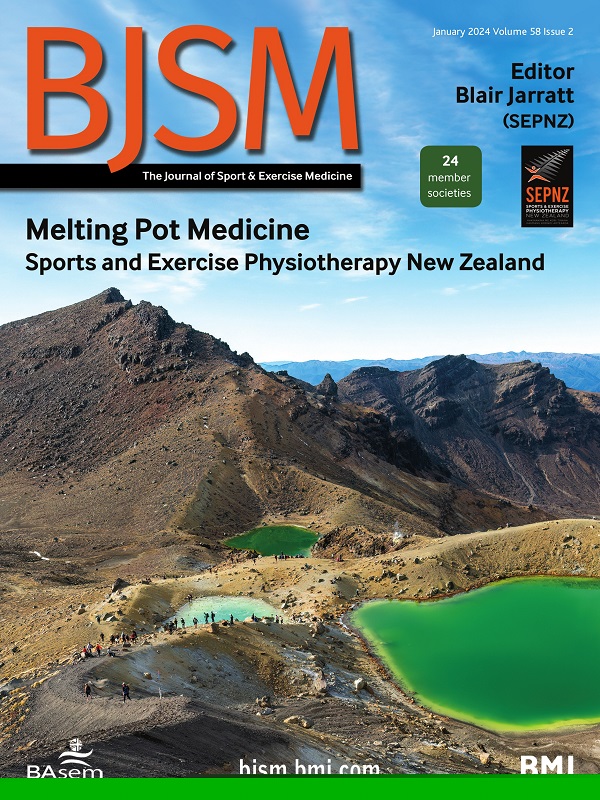肌力训练联合有氧训练与单独有氧训练对冠心病患者心血管疾病风险指标的影响:随机临床试验的系统回顾和荟萃分析
IF 11.6
1区 医学
Q1 SPORT SCIENCES
引用次数: 0
摘要
目的 比较有氧训练联合肌力训练(以下简称联合训练)与单纯有氧训练对冠状动脉疾病(CAD)患者心血管疾病风险指标的影响。设计 系统回顾与荟萃分析。数据来源于 2024 年 2 月检索的 MEDLINE、Embase、CINAHL、SPORTDiscus、Scopus、试验登记处和灰色文献来源。资格标准 比较≥4周的联合训练和单独有氧训练对 CAD 患者心肺功能(CRF)、人体测量和血液动力学指标以及心脏代谢血液生物标志物中至少一项结果的影响的随机临床试验。结果 在筛选出的 13 246 项研究中,有 23 项被纳入(N=916)。与单独进行有氧训练相比,联合训练在增加CRF(标准平均差(SMD)为0.26,95% CI为0.02至0.49,p=0.03)和瘦体重(平均差(MD)为0.78公斤,95% CI为0.39公斤至1.17公斤,p<0.001)以及降低体脂百分比(MD为-2.2%,95% CI为-3.5%至-0.9%,p=0.001)方面更为有效。两组之间的心脏代谢生物标志物没有差异。我们的亚组分析表明,在不影响有氧训练量的情况下,如果在有氧训练中加入肌力训练,联合训练比单纯有氧训练更能增加 CRF(SMD 0.36,95% CI 0.05 至 0.68,p=0.02)。结论 与单独的有氧训练相比,联合训练对冠状动脉粥样硬化患者的CRF和身体成分有更大的影响。要想提高 CAD 患者的 CRF,应在不减少有氧运动量的情况下,在有氧训练的基础上增加肌肉力量训练。与该研究相关的所有数据均包含在文章中或作为补充信息上传。本文章由计算机程序翻译,如有差异,请以英文原文为准。
Effects of muscle strength training combined with aerobic training versus aerobic training alone on cardiovascular disease risk indicators in patients with coronary artery disease: a systematic review and meta-analysis of randomised clinical trials
Objective To compare the effects of aerobic training combined with muscle strength training (hereafter referred to as combined training) to aerobic training alone on cardiovascular disease risk indicators in patients with coronary artery disease (CAD). Design Systematic review with meta-analysis. Data sources MEDLINE, Embase, CINAHL, SPORTDiscus, Scopus, trial registries and grey literature sources were searched in February 2024. Eligibility criteria Randomised clinical trials comparing the effects of ≥4 weeks of combined training and aerobic training alone on at least one of the following outcomes: cardiorespiratory fitness (CRF), anthropometric and haemodynamic measures and cardiometabolic blood biomarkers in patients with CAD. Results Of 13 246 studies screened, 23 were included (N=916). Combined training was more effective in increasing CRF (standard mean difference (SMD) 0.26, 95% CI 0.02 to 0.49, p=0.03) and lean body mass (mean difference (MD) 0.78 kg, 95% CI 0.39 kg to 1.17 kg, p<0.001), and reducing per cent body fat (MD −2.2%, 95% CI −3.5% to −0.9%, p=0.001) compared with aerobic training alone. There were no differences in the cardiometabolic biomarkers between the groups. Our subgroup analyses showed that combined training increases CRF more than aerobic training alone when muscle strength training was added to aerobic training without compromising aerobic training volume (SMD 0.36, 95% CI 0.05 to 0.68, p=0.02). Conclusion Combined training had greater effects on CRF and body composition than aerobic training alone in patients with CAD. To promote an increase in CRF in patients with CAD, muscle strength training should be added to aerobic training without reducing aerobic exercise volume. All data relevant to the study are included in the article or uploaded as supplementary information.
求助全文
通过发布文献求助,成功后即可免费获取论文全文。
去求助
来源期刊
CiteScore
27.10
自引率
4.90%
发文量
217
审稿时长
3-8 weeks
期刊介绍:
The British Journal of Sports Medicine (BJSM) is a dynamic platform that presents groundbreaking research, thought-provoking reviews, and meaningful discussions on sport and exercise medicine. Our focus encompasses various clinically-relevant aspects such as physiotherapy, physical therapy, and rehabilitation. With an aim to foster innovation, education, and knowledge translation, we strive to bridge the gap between research and practical implementation in the field. Our multi-media approach, including web, print, video, and audio resources, along with our active presence on social media, connects a global community of healthcare professionals dedicated to treating active individuals.

 求助内容:
求助内容: 应助结果提醒方式:
应助结果提醒方式:


